fuel consumption TOYOTA RAV4 PLUG-IN HYBRID 2023 Owners Manual
[x] Cancel search | Manufacturer: TOYOTA, Model Year: 2023, Model line: RAV4 PLUG-IN HYBRID, Model: TOYOTA RAV4 PLUG-IN HYBRID 2023Pages: 718, PDF Size: 167.55 MB
Page 92 of 718

902-1. Plug-in hybrid system
Moreover, as fuel consumption is
also reduced when in HV mode, the
regenerative braking system can be
used effectively.
■Regenerative braking
In the following situations, kinetic energy
is converted to electric energy and
deceleration force can be obtained in
conjunction with the recharging of the
hybrid battery (traction battery).
●The accelerator pedal is released
while driving with the shift lever in D or
S.
●The brake pedal is depressed while
driving with the shift lever in D or S.
■EV driving range
●The EV driving range is displayed on
the multi-information display.
(P.187, 193)
●The EV driving range changes in
accordance with the charge status of
the hybrid battery (traction battery),
the speed of the vehicle, etc.
●Even if there is enough charge
remaining in the hybrid battery (trac-
tion battery), EV driving may be can-
celed and both gasoline engine and
electric motor are used depending on
the situation. (P.90)
■EV indicator
The EV indicator comes on when the
vehicle is driven using only the electric
motor (traction motor) or the gasoline
engine is stopped.
The on/off operation of the EV indicator
can be changed. (P.206, 217)
■After EV mode has switched to HV
mode due to low hybrid battery
(traction battery) charge
If the hybrid battery (traction battery) is
regenerated by driving continuously
down a long slope, the EV driving range
etc. will be displayed on the multi-infor-
mation display and EV mode will be
automatically switched to.
If EV mode is not switched to even
though EV driving range is being dis-
played, EV mode can be switched to by
pressing the EV/HV mode selection
switch.
■Gasoline engine operation in EV
mode or AUTO EV/HV mode
Even if there is a sufficient amount of
electricity remaining in the hybrid battery
(traction battery) and EV driving range
(P.201, 213) is being displayed on the
multi-information display, EV driving
(driving using only the electric motor)
may be canceled and both gasoline
engine and electric motor are used
depending on the situation (EV driving
will be returned to automatically after EV
driving becomes possible again).
EV driving may be canceled automati-
cally in the following circumstances
*1:
●When vehicle speed is more than
approximately 135 km/h (84 mph).
●When power is needed temporarily,
for example when the accelerator
pedal is depressed firmly or when
accelerating suddenly.
*2
●When the temperature of the hybrid
system is high.
The vehicle has been left in the sun,
driven on a hill, driven at high speeds,
etc.
●When the temperature of the hybrid
system is low.
●When the heater is switched on when
the outside temperature is below
about -10°C (14°F).
●When the windshield defogger switch
is pressed. (P.431)
●When the system determines that the
Page 94 of 718
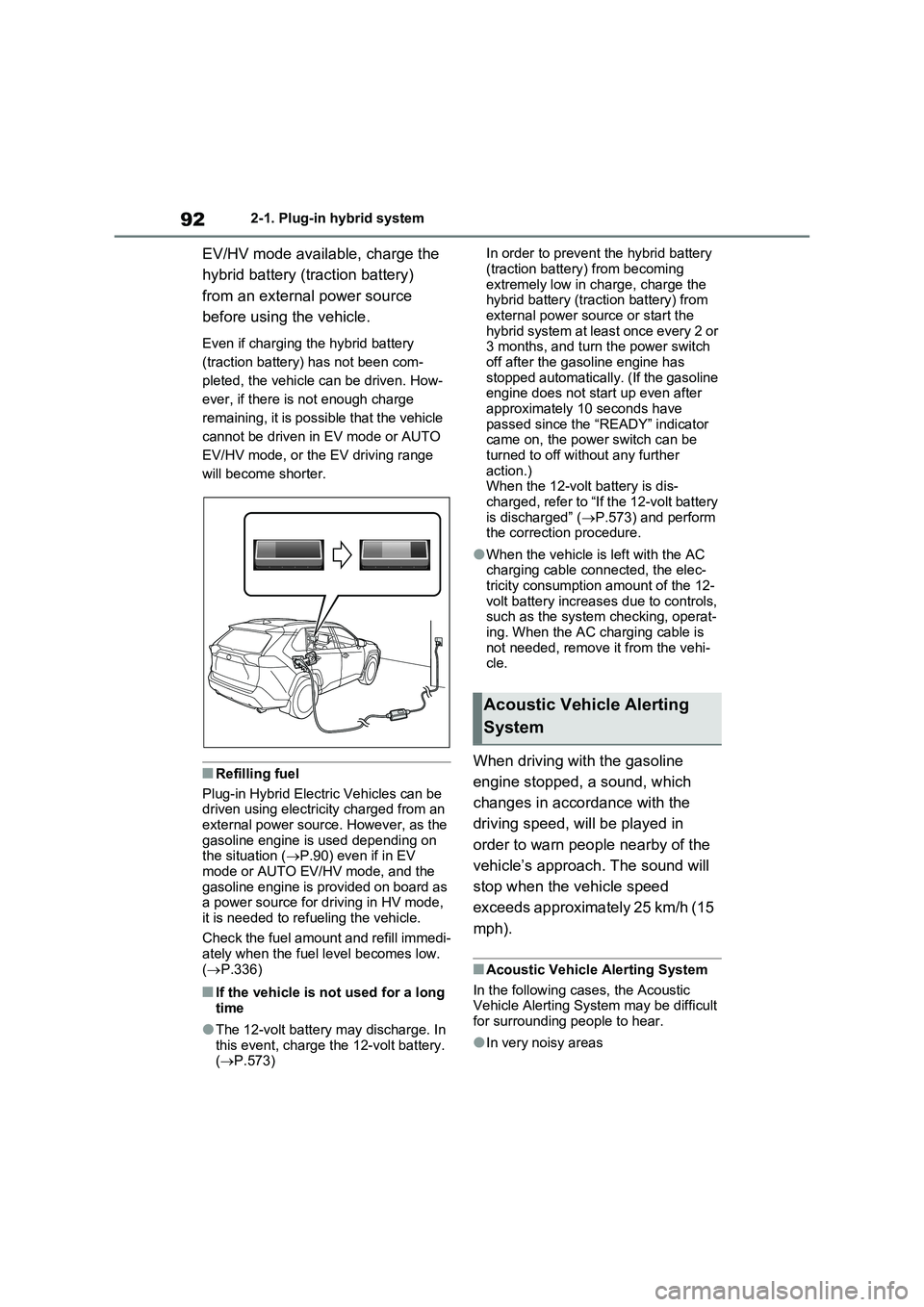
922-1. Plug-in hybrid system
EV/HV mode available, charge the
hybrid battery (traction battery)
from an external power source
before using the vehicle.
Even if charging the hybrid battery
(traction battery) has not been com-
pleted, the vehicle can be driven. How-
ever, if there is not enough charge
remaining, it is possible that the vehicle
cannot be driven in EV mode or AUTO
EV/HV mode, or the EV driving range
will become shorter.
■Refilling fuel
Plug-in Hybrid Electric Vehicles can be driven using electricity charged from an
external power source. However, as the gasoline engine is used depending on the situation ( P.90) even if in EV
mode or AUTO EV/HV mode, and the gasoline engine is provided on board as a power source for driving in HV mode,
it is needed to refueling the vehicle.
Check the fuel amount and refill immedi- ately when the fuel level becomes low.
( P.336)
■If the vehicle is not used for a long time
●The 12-volt battery may discharge. In this event, charge the 12-volt battery. ( P.573)
In order to prevent the hybrid battery
(traction battery) from becoming extremely low in charge, charge the hybrid battery (traction battery) from
external power source or start the hybrid system at least once every 2 or 3 months, and turn the power switch
off after the gasoline engine has stopped automatically. (If the gasoline engine does not start up even after
approximately 10 seconds have passed since the “READY” indicator came on, the power switch can be
turned to off without any further action.)When the 12-volt battery is dis-
charged, refer to “If the 12-volt battery is discharged” ( P.573) and perform the correction procedure.
●When the vehicle is left with the AC charging cable connected, the elec-
tricity consumption amount of the 12- volt battery increases due to controls, such as the system checking, operat-
ing. When the AC charging cable is not needed, remove it from the vehi-cle.
When driving with the gasoline
engine stopped, a sound, which
changes in accordance with the
driving speed, will be played in
order to warn people nearby of the
vehicle’s approach. The sound will
stop when the vehicle speed
exceeds approximately 25 km/h (15
mph).
■Acoustic Vehicle Alerting System
In the following cases, the Acoustic Vehicle Alerting System may be difficult for surrounding people to hear.
●In very noisy areas
Acoustic Vehicle Alerting
System
Page 103 of 718
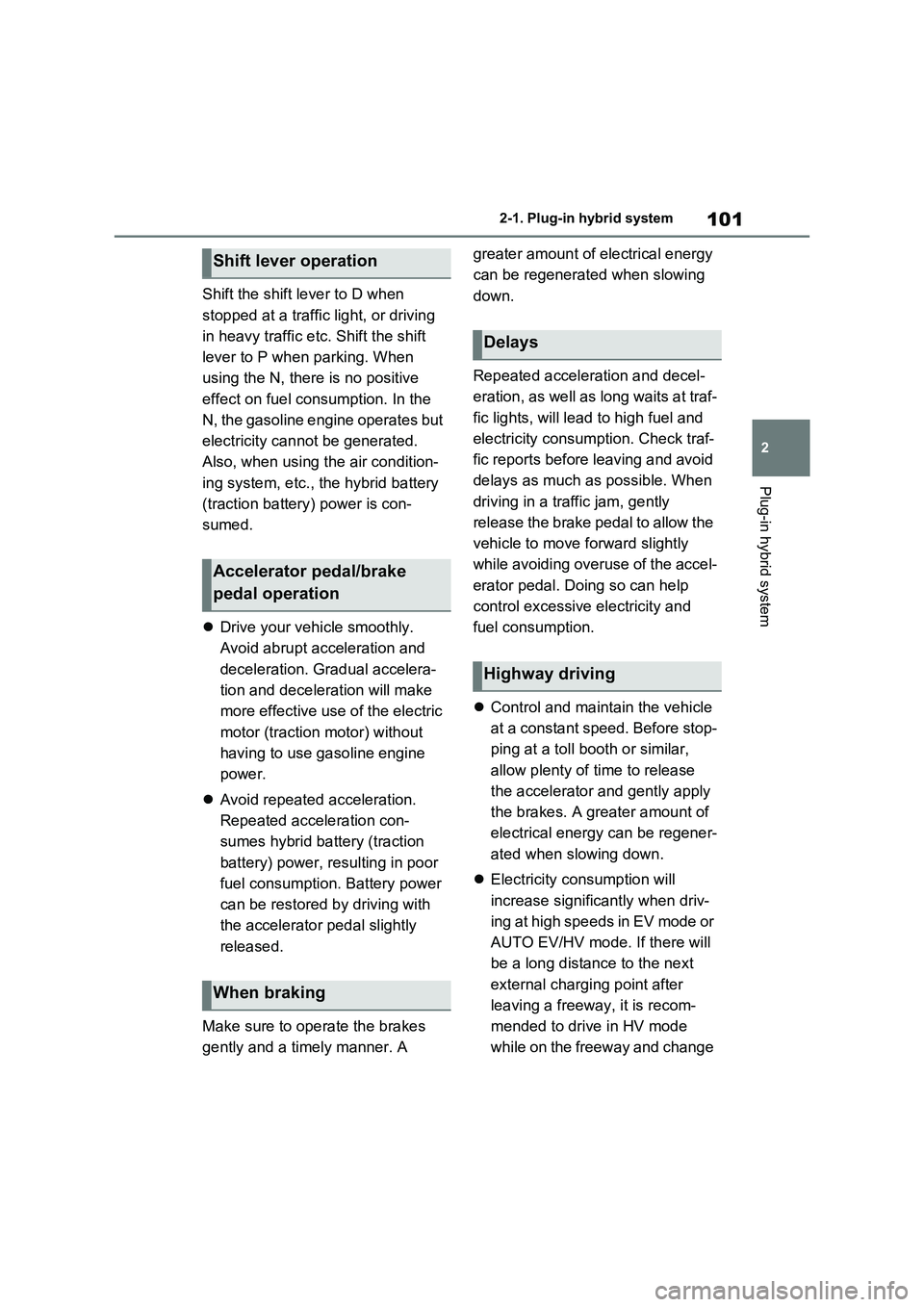
101
2 2-1. Plug-in hybrid system
Plug-in hybrid system
Shift the shift lever to D when
stopped at a traffic light, or driving
in heavy traffic etc. Shift the shift
lever to P when parking. When
using the N, there is no positive
effect on fuel consumption. In the
N, the gasoline engine operates but
electricity cannot be generated.
Also, when using the air condition-
ing system, etc., the hybrid battery
(traction battery) power is con-
sumed.
Drive your vehicle smoothly.
Avoid abrupt acceleration and
deceleration. Gradual accelera-
tion and deceleration will make
more effective use of the electric
motor (traction motor) without
having to use gasoline engine
power.
Avoid repeated acceleration.
Repeated acceleration con-
sumes hybrid battery (traction
battery) power, resulting in poor
fuel consumption. Battery power
can be restored by driving with
the accelerator pedal slightly
released.
Make sure to operate the brakes
gently and a timely manner. A greater amount of electrical energy
can be regenerated when slowing
down.
Repeated acceleration and decel-
eration, as well as long waits at traf-
fic lights, will lead to high fuel and
electricity consumption. Check traf-
fic reports before leaving and avoid
delays as much as possible. When
driving in a traffic jam, gently
release the brake pedal to allow the
vehicle to move forward slightly
while avoiding overuse of the accel-
erator pedal. Doing so can help
control excessive electricity and
fuel consumption.
Control and maintain the vehicle
at a constant speed. Before stop-
ping at a toll booth or similar,
allow plenty of time to release
the accelerator and gently apply
the brakes. A greater amount of
electrical energy can be regener-
ated when slowing down.
Electricity consumption will
increase significantly when driv-
ing at high speeds in EV mode or
AUTO EV/HV mode. If there will
be a long distance to the next
external charging point after
leaving a freeway, it is recom-
mended to drive in HV mode
while on the freeway and change
Shift lever operation
Accelerator pedal/brake
pedal operation
When braking
Delays
Highway driving
Page 104 of 718
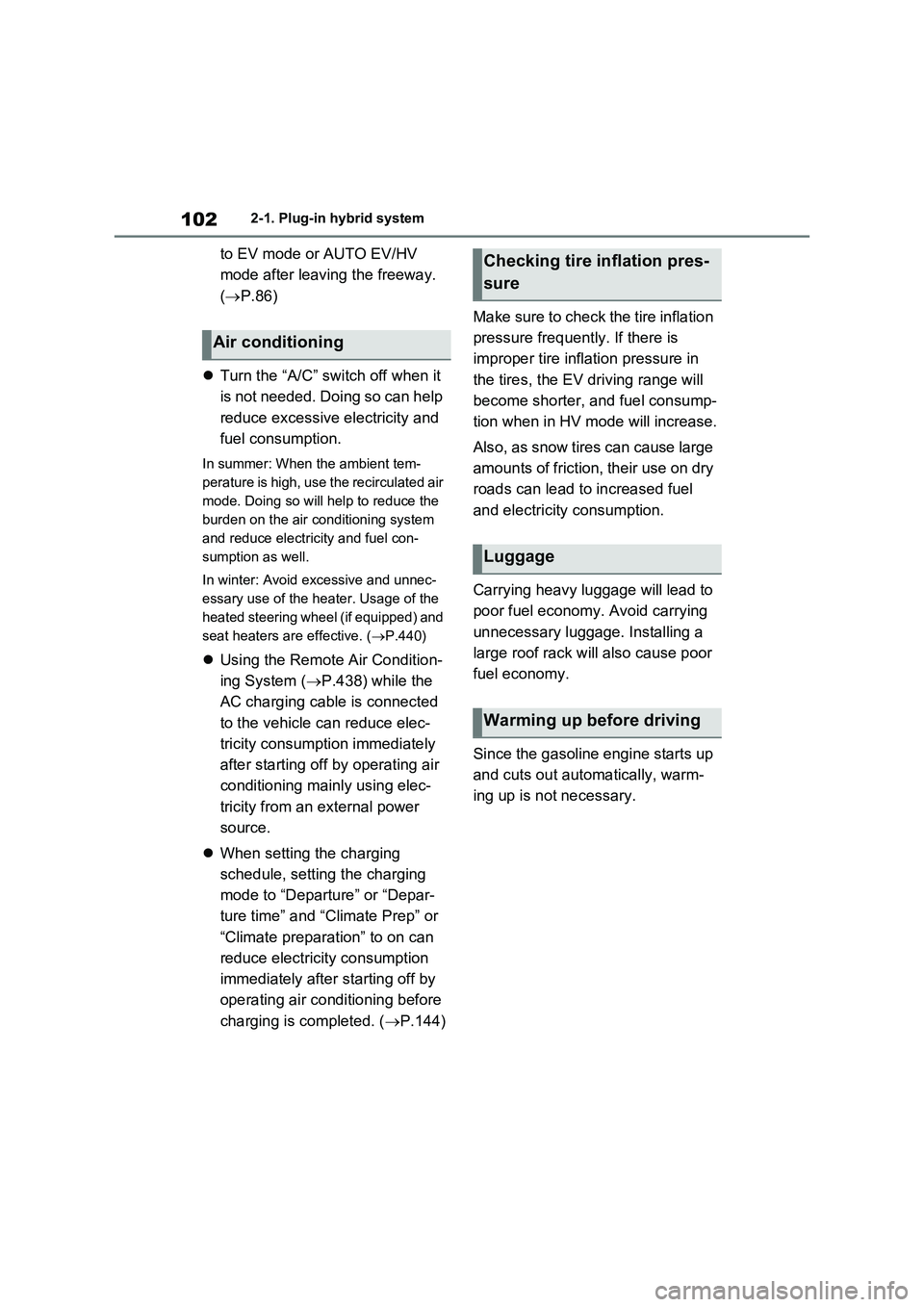
1022-1. Plug-in hybrid system
to EV mode or AUTO EV/HV
mode after leaving the freeway.
(P.86)
Turn the “A/C” switch off when it
is not needed. Doing so can help
reduce excessive electricity and
fuel consumption.
In summer: When the ambient tem-
perature is high, use the recirculated air
mode. Doing so will help to reduce the
burden on the air conditioning system
and reduce electricity and fuel con-
sumption as well.
In winter: Avoid excessive and unnec-
essary use of the heater. Usage of the
heated steering wheel (if equipped) and
seat heaters are effective. (P.440)
Using the Remote Air Condition-
ing System (P.438) while the
AC charging cable is connected
to the vehicle can reduce elec-
tricity consumption immediately
after starting off by operating air
conditioning mainly using elec-
tricity from an external power
source.
When setting the charging
schedule, setting the charging
mode to “Departure” or “Depar-
ture time” and “Climate Prep” or
“Climate preparation” to on can
reduce electricity consumption
immediately after starting off by
operating air conditioning before
charging is completed. (P.144)Make sure to check the tire inflation
pressure frequently. If there is
improper tire inflation pressure in
the tires, the EV driving range will
become shorter, and fuel consump-
tion when in HV mode will increase.
Also, as snow tires can cause large
amounts of friction, their use on dry
roads can lead to increased fuel
and electricity consumption.
Carrying heavy luggage will lead to
poor fuel economy. Avoid carrying
unnecessary luggage. Installing a
large roof rack will also cause poor
fuel economy.
Since the gasoline engine starts up
and cuts out automatically, warm-
ing up is not necessary.
Air conditioning
Checking tire inflation pres-
sure
Luggage
Warming up before driving
Page 106 of 718
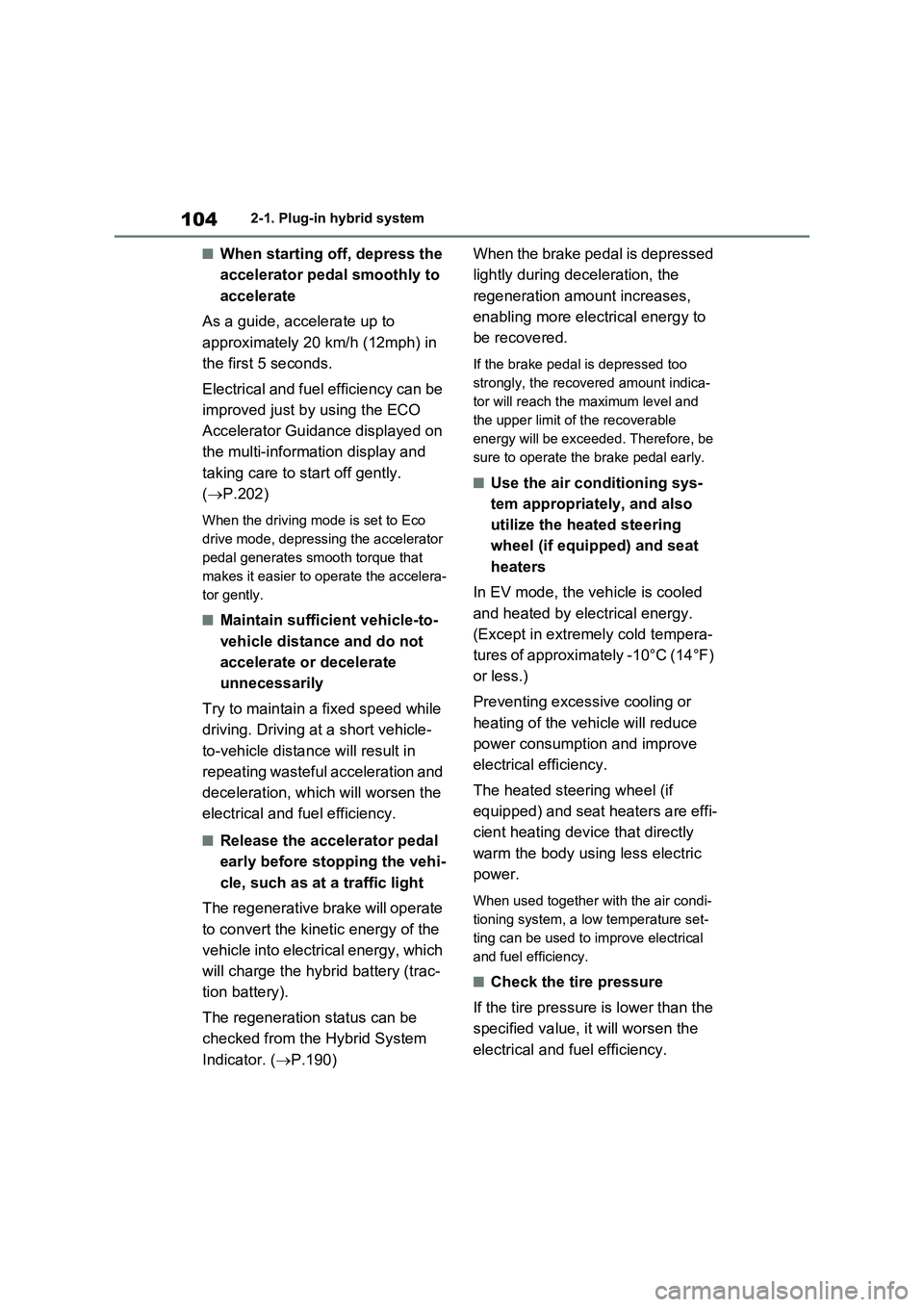
1042-1. Plug-in hybrid system
■When starting off, depress the
accelerator pedal smoothly to
accelerate
As a guide, accelerate up to
approximately 20 km/h (12mph) in
the first 5 seconds.
Electrical and fuel efficiency can be
improved just by using the ECO
Accelerator Guidance displayed on
the multi-information display and
taking care to start off gently.
(P.202)
When the driving mode is set to Eco
drive mode, depressing the accelerator
pedal generates smooth torque that
makes it easier to operate the accelera-
tor gently.
■Maintain sufficient vehicle-to-
vehicle distance and do not
accelerate or decelerate
unnecessarily
Try to maintain a fixed speed while
driving. Driving at a short vehicle-
to-vehicle distance will result in
repeating wasteful acceleration and
deceleration, which will worsen the
electrical and fuel efficiency.
■Release the accelerator pedal
early before stopping the vehi-
cle, such as at a traffic light
The regenerative brake will operate
to convert the kinetic energy of the
vehicle into electrical energy, which
will charge the hybrid battery (trac-
tion battery).
The regeneration status can be
checked from the Hybrid System
Indicator. (P.190)When the brake pedal is depressed
lightly during deceleration, the
regeneration amount increases,
enabling more electrical energy to
be recovered.
If the brake pedal is depressed too
strongly, the recovered amount indica-
tor will reach the maximum level and
the upper limit of the recoverable
energy will be exceeded. Therefore, be
sure to operate the brake pedal early.
■Use the air conditioning sys-
tem appropriately, and also
utilize the heated steering
wheel (if equipped) and seat
heaters
In EV mode, the vehicle is cooled
and heated by electrical energy.
(Except in extremely cold tempera-
tures of approximately -10°C (14°F)
or less.)
Preventing excessive cooling or
heating of the vehicle will reduce
power consumption and improve
electrical efficiency.
The heated steering wheel (if
equipped) and seat heaters are effi-
cient heating device that directly
warm the body using less electric
power.
When used together with the air condi-
tioning system, a low temperature set-
ting can be used to improve electrical
and fuel efficiency.
■Check the tire pressure
If the tire pressure is lower than the
specified value, it will worsen the
electrical and fuel efficiency.
Page 107 of 718
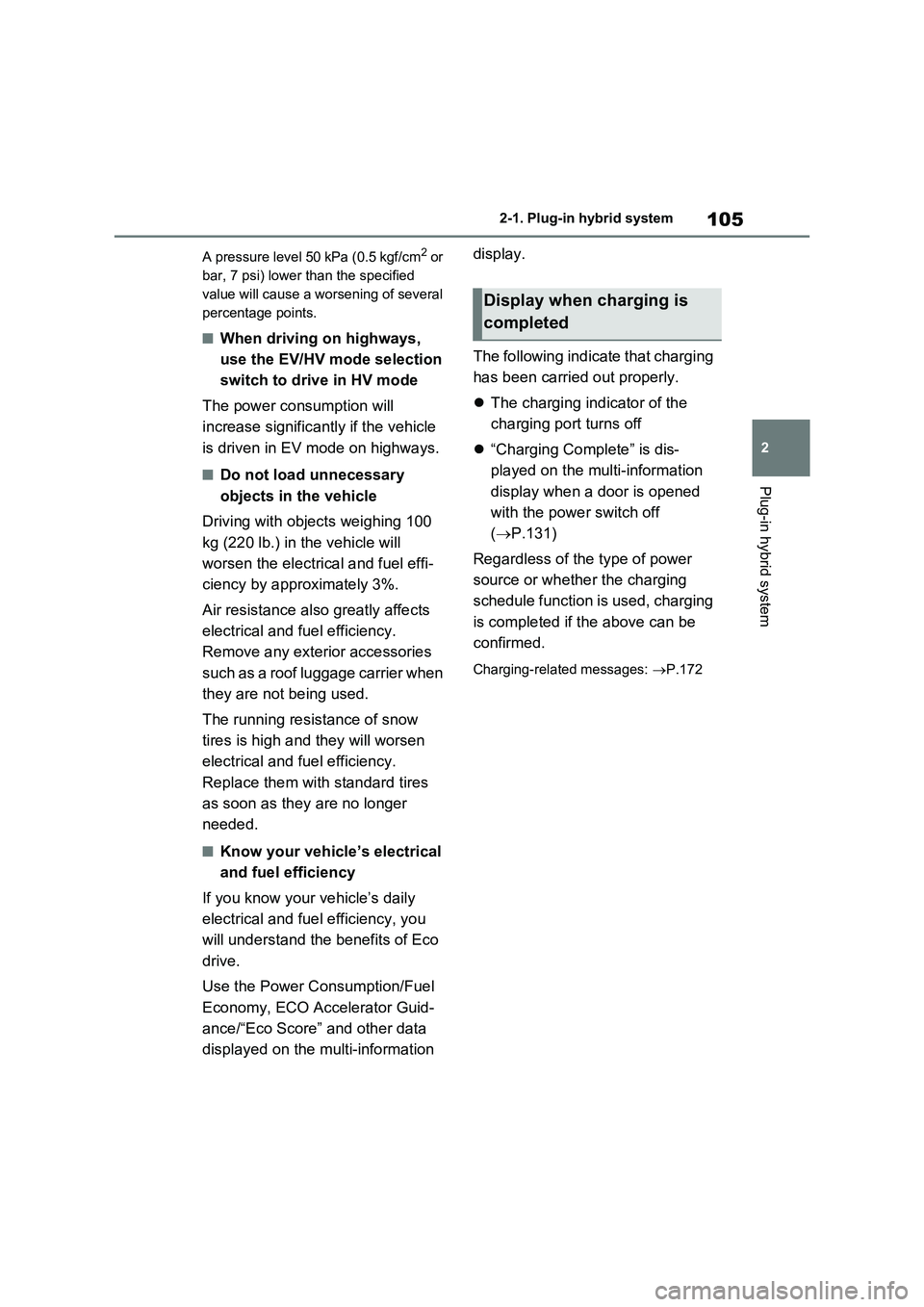
105
2 2-1. Plug-in hybrid system
Plug-in hybrid system
A pressure level 50 kPa (0.5 kgf/cm2 or
bar, 7 psi) lower than the specified
value will cause a worsening of several
percentage points.
■When driving on highways,
use the EV/HV mode selection
switch to drive in HV mode
The power consumption will
increase significantly if the vehicle
is driven in EV mode on highways.
■Do not load unnecessary
objects in the vehicle
Driving with objects weighing 100
kg (220 lb.) in the vehicle will
worsen the electrical and fuel effi-
ciency by approximately 3%.
Air resistance also greatly affects
electrical and fuel efficiency.
Remove any exterior accessories
such as a roof luggage carrier when
they are not being used.
The running resistance of snow
tires is high and they will worsen
electrical and fuel efficiency.
Replace them with standard tires
as soon as they are no longer
needed.
■Know your vehicle’s electrical
and fuel efficiency
If you know your vehicle’s daily
electrical and fuel efficiency, you
will understand the benefits of Eco
drive.
Use the Power Consumption/Fuel
Economy, ECO Accelerator Guid-
ance/“Eco Score” and other data
displayed on the multi-information display.
The following indicate that charging
has been carried out properly.
The charging indicator of the
charging port turns off
“Charging Complete” is dis-
played on the multi-information
display when a door is opened
with the power switch off
(P.131)
Regardless of the type of power
source or whether the charging
schedule function is used, charging
is completed if the above can be
confirmed.
Charging-related messages: P.172
Display when charging is
completed
Page 196 of 718
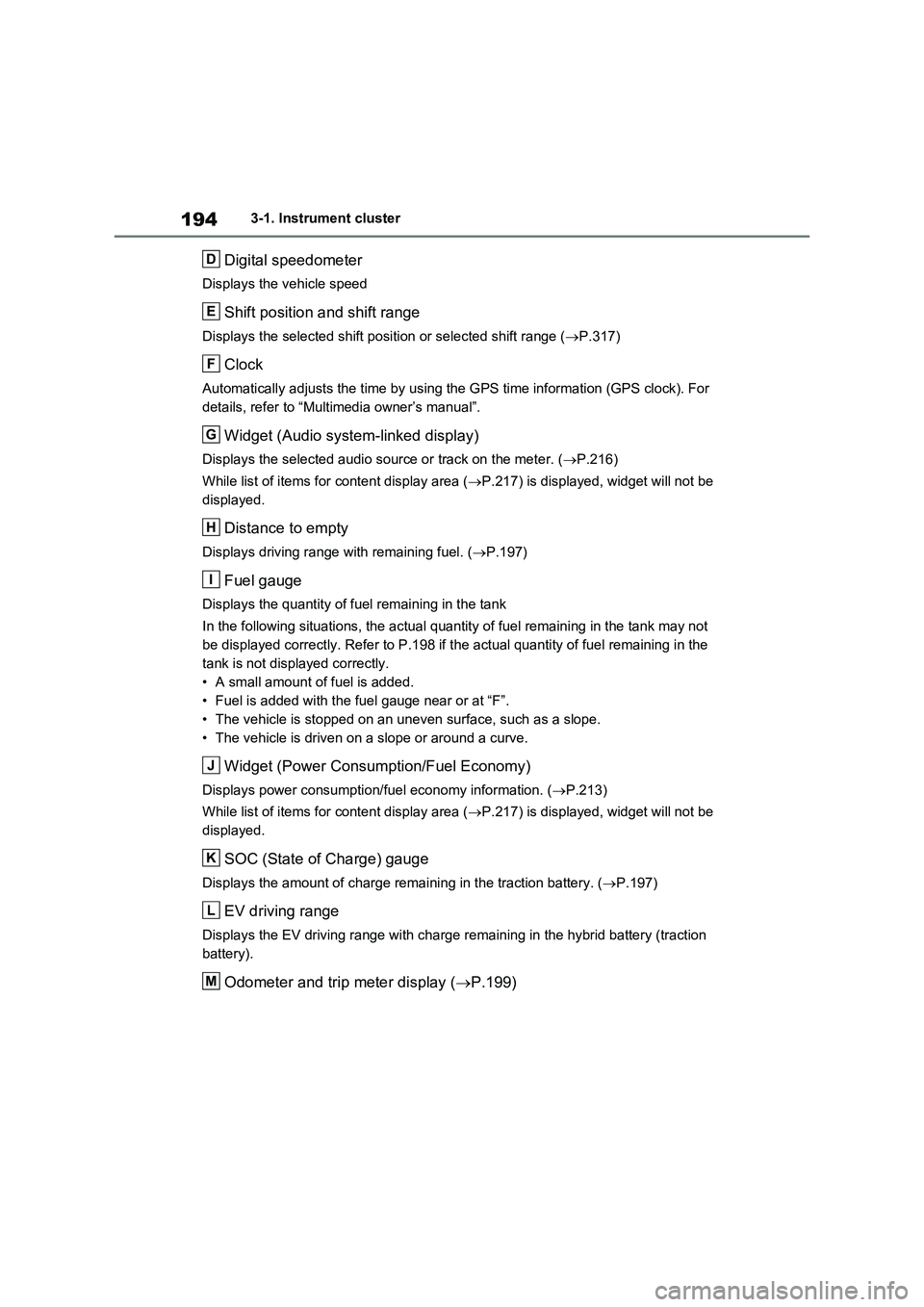
1943-1. Instrument cluster
Digital speedometer
Displays the vehicle speed
Shift position and shift range
Displays the selected shift position or selected shift range (P.317)
Clock
Automatically adjusts the time by using the GPS time information (GPS clock). For
details, refer to “Multimedia owner’s manual”.
Widget (Audio system-linked display)
Displays the selected audio source or track on the meter. (P.216)
While list of items for content display area (P.217) is displayed, widget will not be
displayed.
Distance to empty
Displays driving range with remaining fuel. (P.197)
Fuel gauge
Displays the quantity of fuel remaining in the tank
In the following situations, the actual quantity of fuel remaining in the tank may not
be displayed correctly. Refer to P.198 if the actual quantity of fuel remaining in the
tank is not displayed correctly.
• A small amount of fuel is added.
• Fuel is added with the fuel gauge near or at “F”.
• The vehicle is stopped on an uneven surface, such as a slope.
• The vehicle is driven on a slope or around a curve.
Widget (Power Consumption/Fuel Economy)
Displays power consumption/fuel economy information. (P.213)
While list of items for content display area (P.217) is displayed, widget will not be
displayed.
SOC (State of Charge) gauge
Displays the amount of charge remaining in the traction battery. (P.197)
EV driving range
Displays the EV driving range with charge remaining in the hybrid battery (traction
battery).
Odometer and trip meter display (P.199)
D
E
F
G
H
I
J
K
L
M
Page 199 of 718
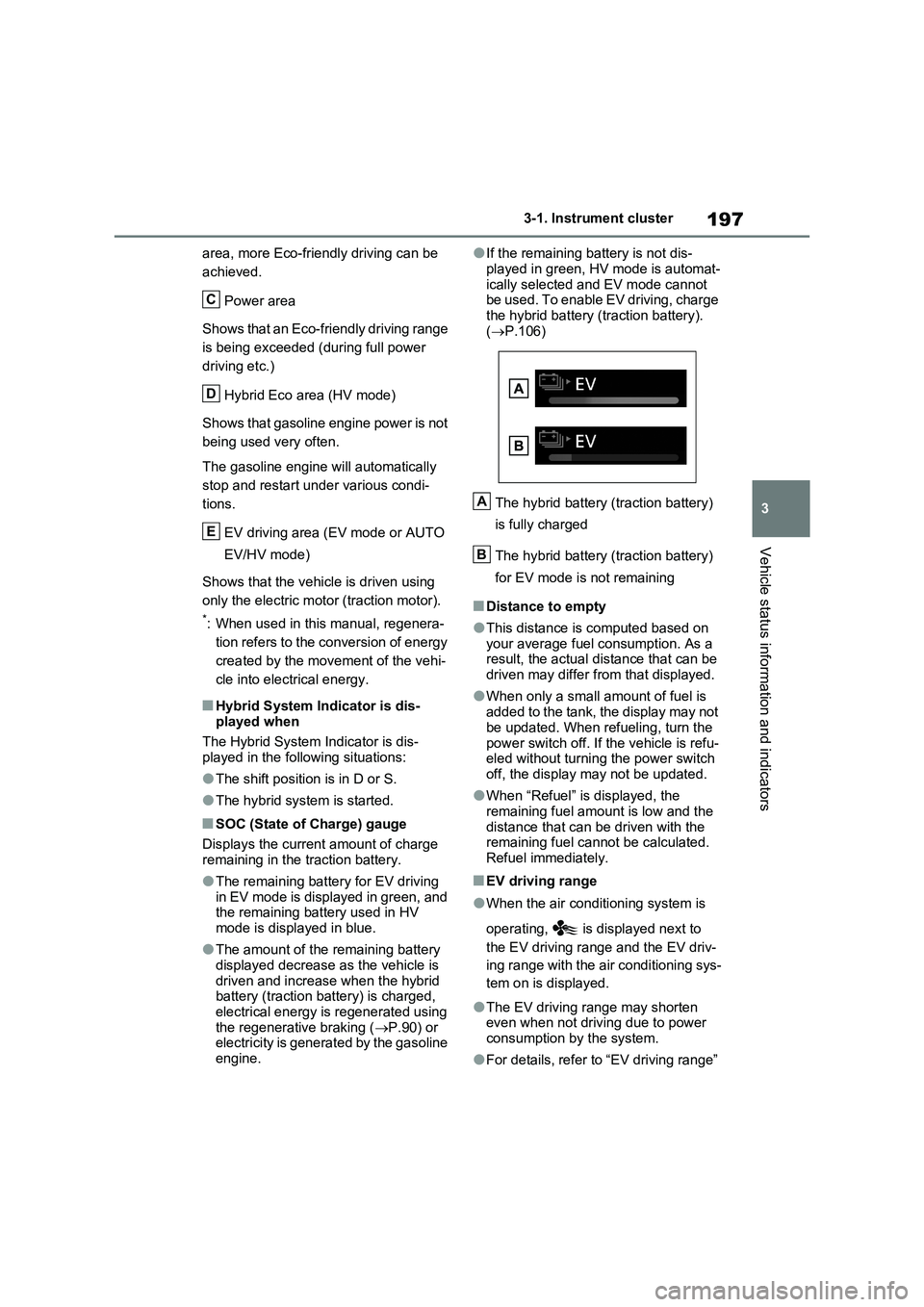
197
3 3-1. Instrument cluster
Vehicle status information and indicators
area, more Eco-friendly driving can be
achieved.
Power area
Shows that an Eco-friendly driving range
is being exceeded (during full power
driving etc.)
Hybrid Eco area (HV mode)
Shows that gasoline engine power is not
being used very often.
The gasoline engine will automatically
stop and restart under various condi-
tions.
EV driving area (EV mode or AUTO
EV/HV mode)
Shows that the vehicle is driven using
only the electric motor (traction motor).
*: When used in this manual, regenera-
tion refers to the conversion of energy
created by the movement of the vehi-
cle into electrical energy.
■Hybrid System Indicator is dis-
played when
The Hybrid System Indicator is dis-
played in the following situations:
●The shift position is in D or S.
●The hybrid system is started.
■SOC (State of Charge) gauge
Displays the current amount of charge
remaining in the traction battery.
●The remaining battery for EV driving
in EV mode is displayed in green, and
the remaining battery used in HV
mode is displayed in blue.
●The amount of the remaining battery
displayed decrease as the vehicle is
driven and increase when the hybrid
battery (traction battery) is charged,
electrical energy is regenerated using
the regenerative braking (P.90) or
electricity is generated by the gasoline
engine.
●If the remaining battery is not dis-
played in green, HV mode is automat-
ically selected and EV mode cannot
be used. To enable EV driving, charge
the hybrid battery (traction battery).
(P.106)
The hybrid battery (traction battery)
is fully charged
The hybrid battery (traction battery)
for EV mode is not remaining
■Distance to empty
●This distance is computed based on
your average fuel consumption. As a
result, the actual distance that can be
driven may differ from that displayed.
●When only a small amount of fuel is
added to the tank, the display may not
be updated. When refueling, turn the
power switch off. If the vehicle is refu-
eled without turning the power switch
off, the display may not be updated.
●When “Refuel” is displayed, the
remaining fuel amount is low and the
distance that can be driven with the
remaining fuel cannot be calculated.
Refuel immediately.
■EV driving range
●When the air conditioning system is
operating, is displayed next to
the EV driving range and the EV driv-
ing range with the air conditioning sys-
tem on is displayed.
●The EV driving range may shorten
even when not driving due to power
consumption by the system.
●For details, refer to “EV driving range”
C
D
E
A
B
Page 203 of 718
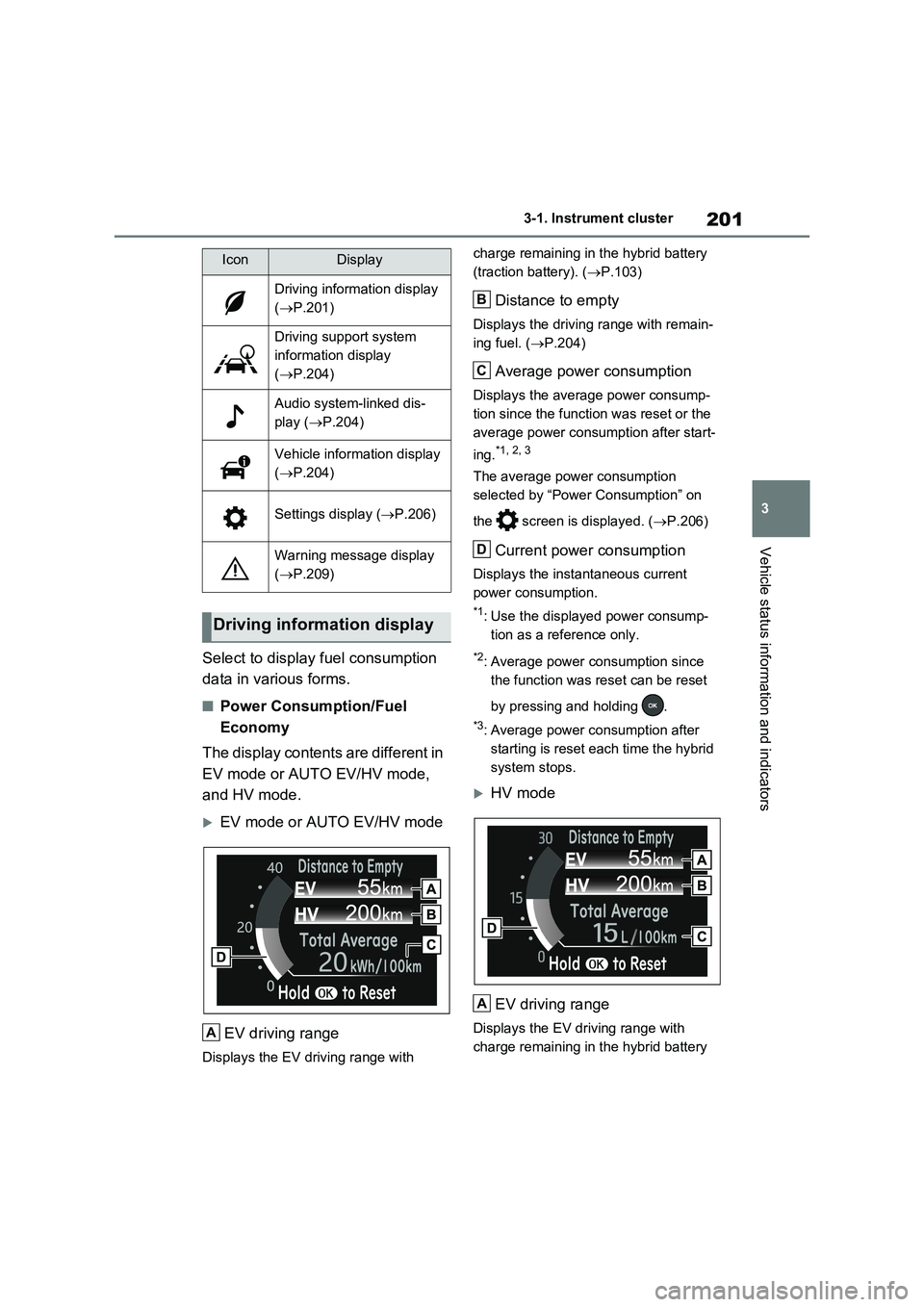
201
3 3-1. Instrument cluster
Vehicle status information and indicators
Select to display fuel consumption
data in various forms.
■Power Consumption/Fuel
Economy
The display contents are different in
EV mode or AUTO EV/HV mode,
and HV mode.
EV mode or AUTO EV/HV mode
EV driving range
Displays the EV driving range with charge remaining in the hybrid battery
(traction battery). (P.103)
Distance to empty
Displays the driving range with remain-
ing fuel. (P.204)
Average power consumption
Displays the average power consump-
tion since the function was reset or the
average power consumption after start-
ing.
*1, 2, 3
The average power consumption
selected by “Power Consumption” on
the screen is displayed. (P.206)
Current power consumption
Displays the instantaneous current
power consumption.
*1: Use the displayed power consump-
tion as a reference only.
*2: Average power consumption since
the function was reset can be reset
by pressing and holding .
*3: Average power consumption after
starting is reset each time the hybrid
system stops.
HV mode
EV driving range
Displays the EV driving range with
charge remaining in the hybrid battery
IconDisplay
Driving information display
(P.201)
Driving support system
information display
(P.204)
Audio system-linked dis-
play (P.204)
Vehicle information display
(P.204)
Settings display (P.206)
Warning message display
(P.209)
Driving information display
A
B
C
D
A
Page 204 of 718
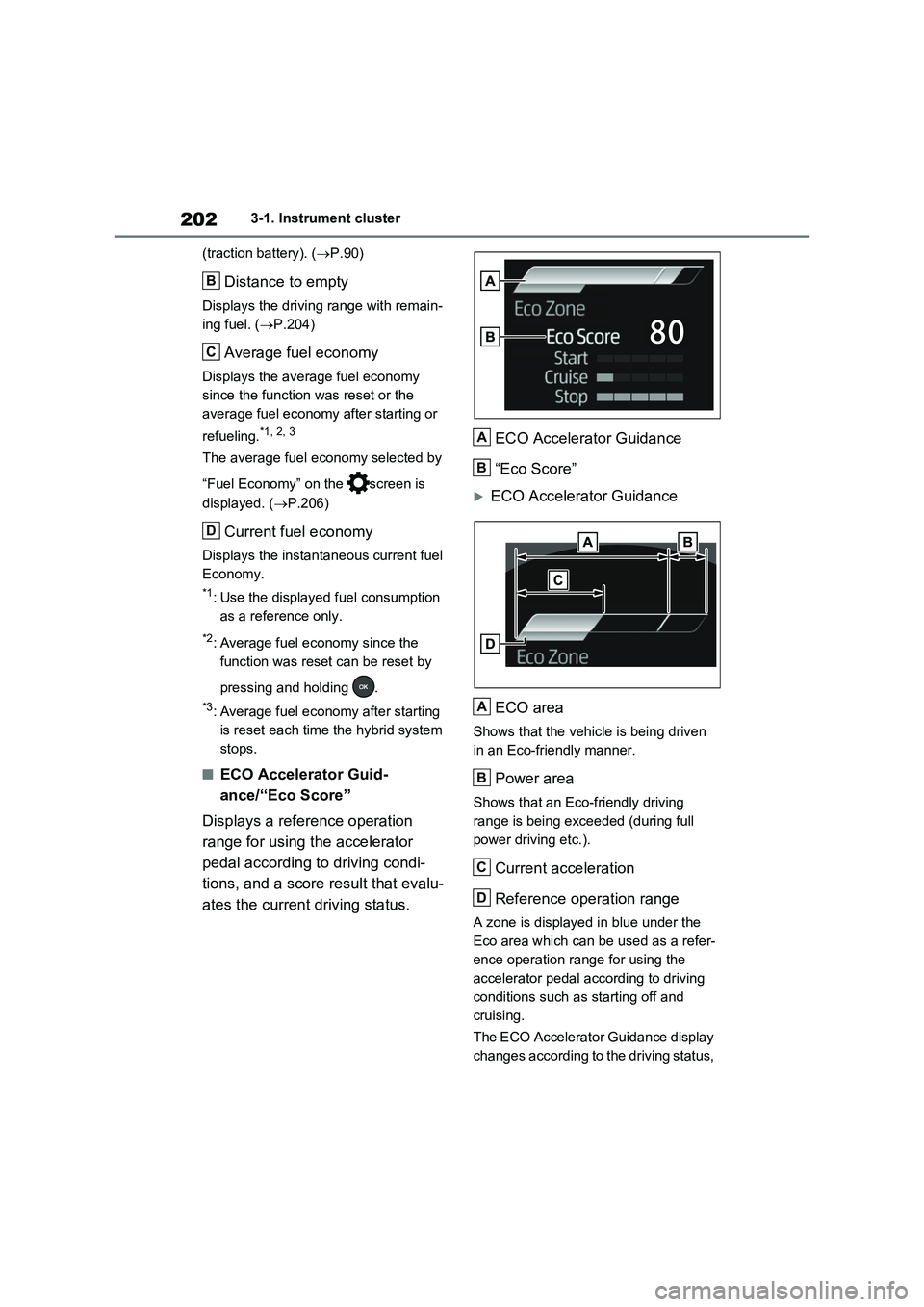
2023-1. Instrument cluster
(traction battery). (P.90)
Distance to empty
Displays the driving range with remain-
ing fuel. (P.204)
Average fuel economy
Displays the average fuel economy
since the function was reset or the
average fuel economy after starting or
refueling.
*1, 2, 3
The average fuel economy selected by
“Fuel Economy” on the screen is
displayed. (P.206)
Current fuel economy
Displays the instantaneous current fuel
Economy.
*1: Use the displayed fuel consumption
as a reference only.
*2: Average fuel economy since the
function was reset can be reset by
pressing and holding .
*3: Average fuel economy after starting
is reset each time the hybrid system
stops.
■ECO Accelerator Guid-
ance/“Eco Score”
Displays a reference operation
range for using the accelerator
pedal according to driving condi-
tions, and a score result that evalu-
ates the current driving status.ECO Accelerator Guidance
“Eco Score”
ECO Accelerator Guidance
ECO area
Shows that the vehicle is being driven
in an Eco-friendly manner.
Power area
Shows that an Eco-friendly driving
range is being exceeded (during full
power driving etc.).
Current acceleration
Reference operation range
A zone is displayed in blue under the
Eco area which can be used as a refer-
ence operation range for using the
accelerator pedal according to driving
conditions such as starting off and
cruising.
The ECO Accelerator Guidance display
changes according to the driving status,
B
C
D
A
B
A
B
C
D